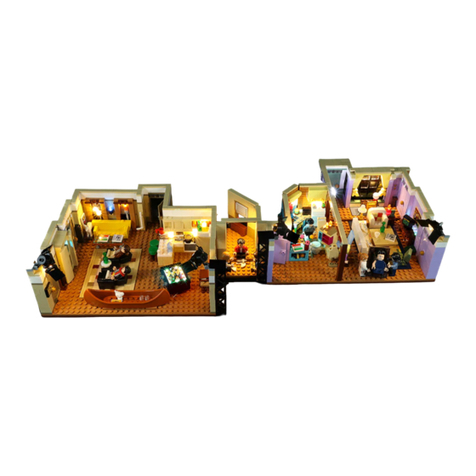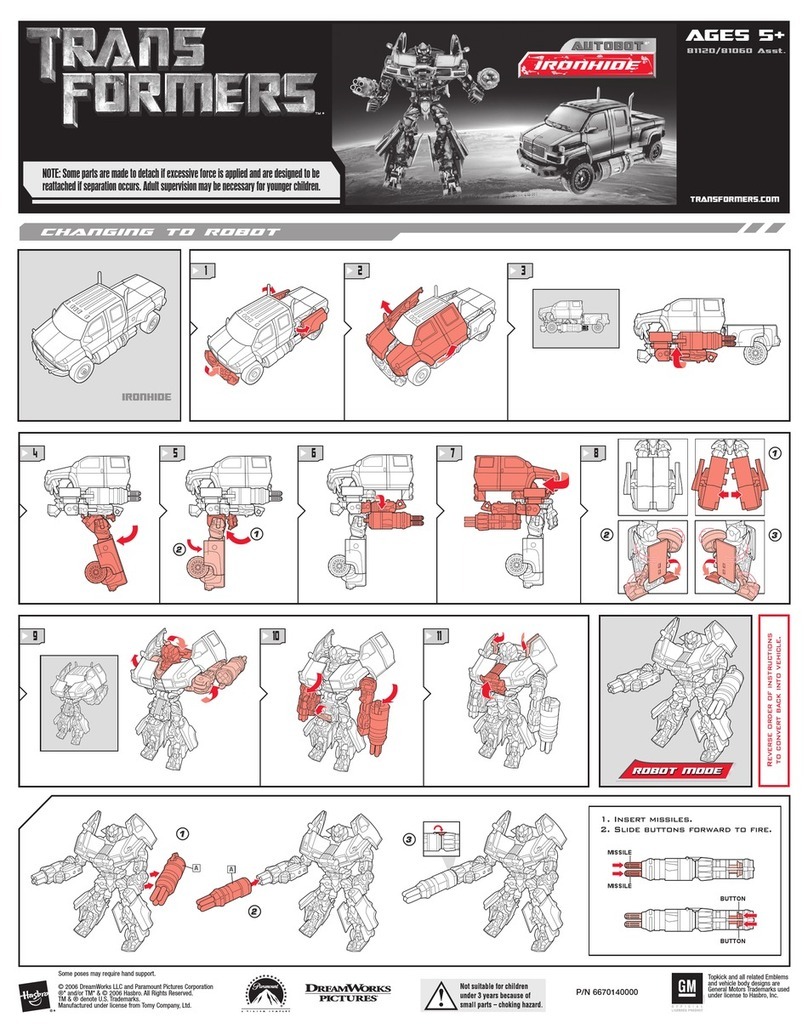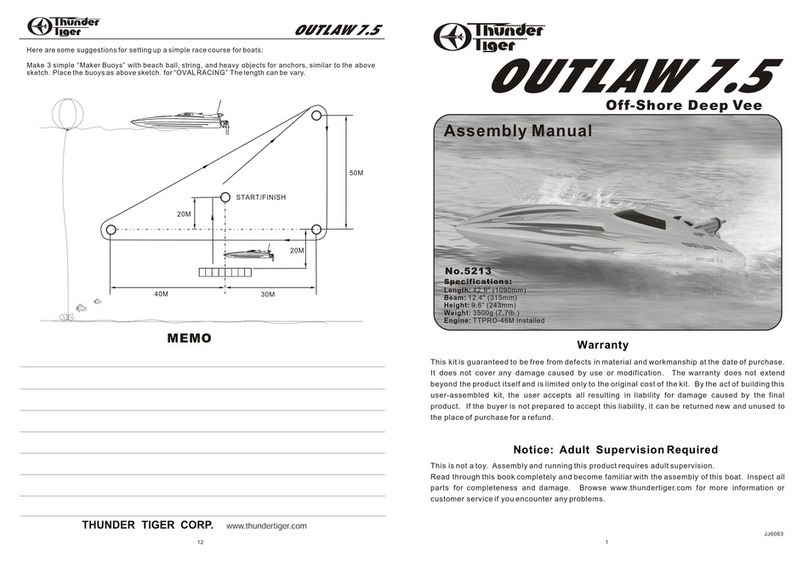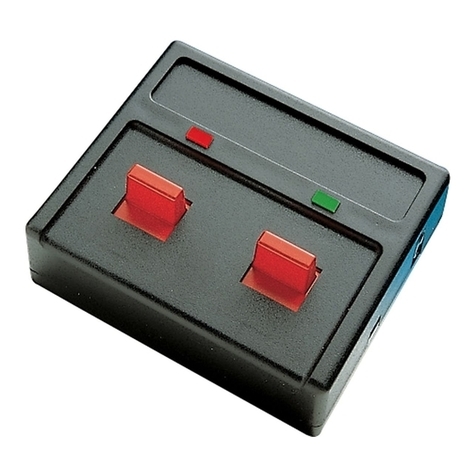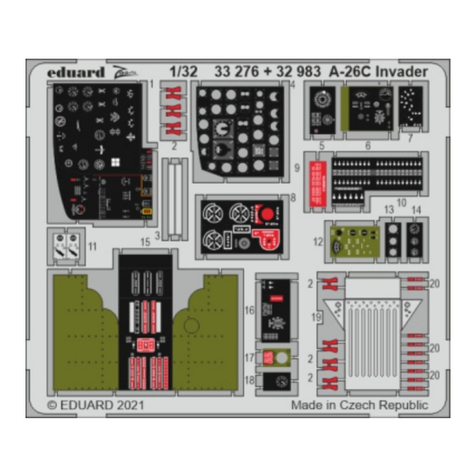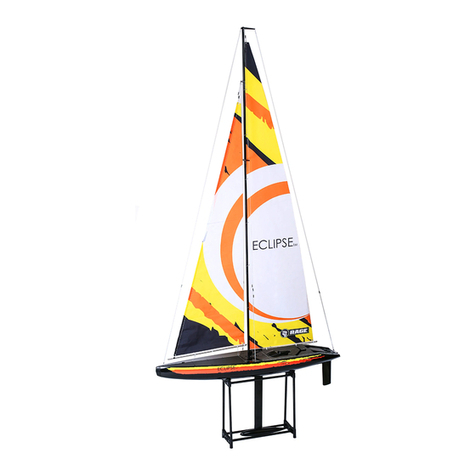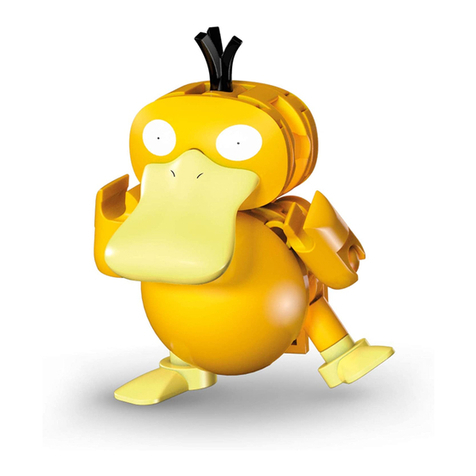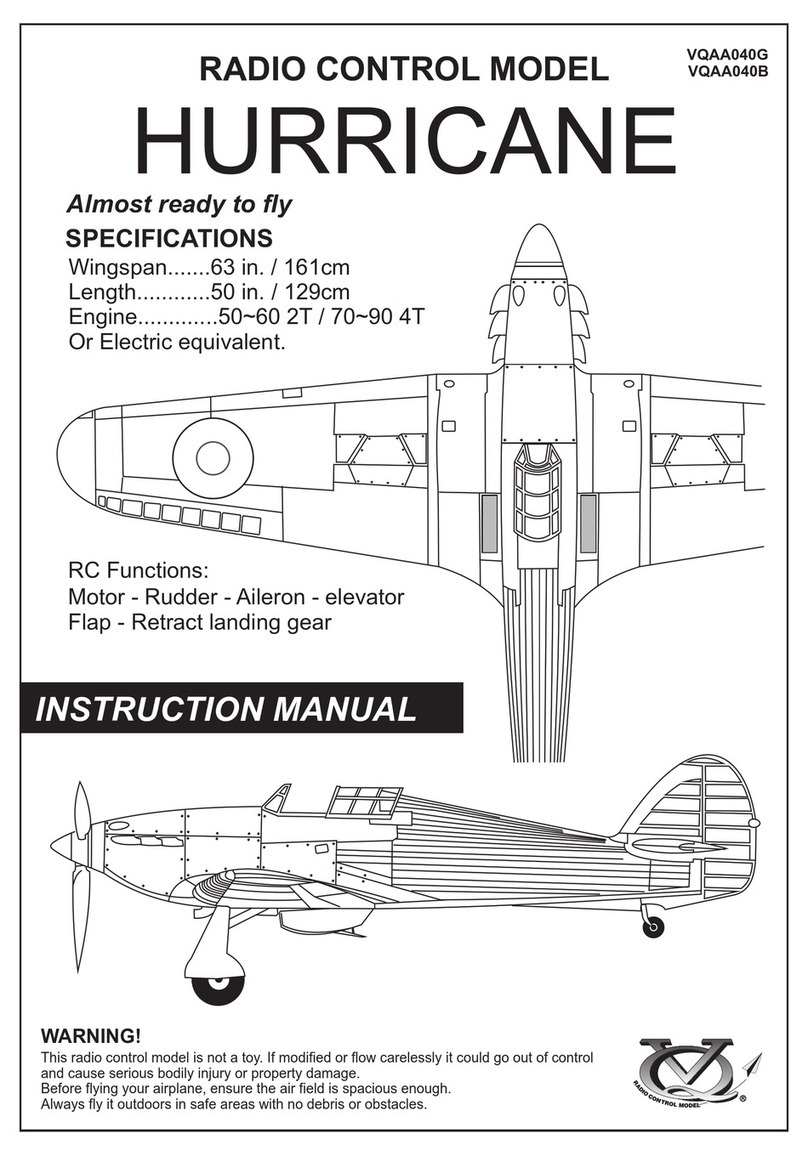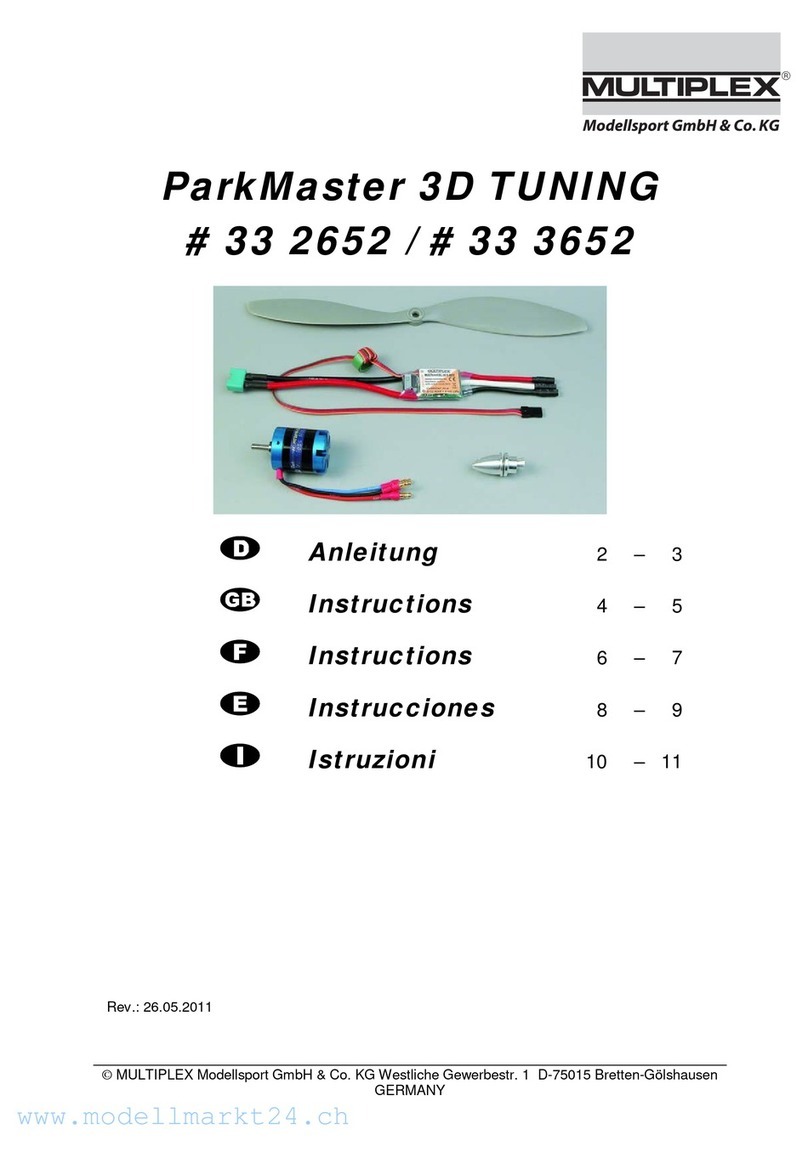R.L.W. McCabe Lumber Co. Slatyfork Sawmill Interior User manual

History
Empty sawmills are lonely places. This kit includes all the
machineryandbasicdetailsneededtodeckouttheSlatyfork
Sawmill main floor and sawfiler's area.
Instructions
Read the instructions completely and study the photos and
drawings before starting construction!
Warranty
All R.L.W. products are guaranteed against defects in
manufacturing and will be replaced or repaired as
determined by R.L.W. after inspection of the part. Contact
R.L.W for a return authorization prior to returning any
damaged parts. R.L.W will also replace parts that are
damaged during assembly. This part of the warranty is
voided if the kit has been modified in any way.
Drop Outs
The laser-cut sheets may look like pieces are missing, but
these holes are intentional. These waste pieces, called drop
outs, may still be clinging to the sheet and fall out when
touched. Save them for use as clutter and scraps when doing
the final detailing.
McCabe Lumber Co.
Slatyfork Sawmill Interior
#28301 N Scale
Remove the pieces from the carrier sheets with a sharp
hobby knife as they are needed, and lightly sand off the
remainder of the tabs. On the thicker pieces there is a slight
draft angle caused by the laser. This angle can be removed
with a pass or two of a fine sanding block.
Identify all the parts, checking them against the parts list. Most
wood parts have a number either on them or nearby. Extra
small parts may be included. Do not remove the parts from the
carrier yet!
Repetitive Steps
Every different procedure or method is discussed in detail
in the instructions; however, once it has been discussed, it
is not repeated in detail again.
Dimensions and Directions
Alldimensionsspecifiedinthetextareactualfeetandinches
unless used with the word “scale” before or after them.
Atmospheric Conditions
Wood and paper products are effectively live materials on
which humidity and temperature changes will change the
size of parts slightly.
R.L.W.R.L.W.
R.L.W.R.L.W.
R.L.W.

McCabe Lumber Company
2
End User Information
This kit is not intended for use by novice modelers, or
individuals under the age of 18 without the supervision of
an adult. Additionally, the modeler assumes all liability
regarding the proper use of this product or any product
suggested. The user must become familiar with the kit
instructions, and instructions on any product used to
complete this kit. Please read and follow all safety
procedures for all products used to finish this kit. Details
mayvarybetweenscalesandfromthesamplemodelshown.
Color Pallet
The basic colors are from the Floquil railroad colors line
except as noted. You may follow our suggested pallet:
Coach Green Stainless Steel
Rust Reefer Gray
Rail Tie Brown Caboose Red
Aged Concrete Antique White
Earth Grimy Black
Woodland Scenics' Mini-Scene Paint Set
Naturally, you may use any colors you wish. Just
remember that flat, dull colors are preferable to loud bright
colors for a realistically-finished model. Some colors
apparent in the photos are mixtures of two or more of the
basic colors. These mixtures are used only on detail items
and are not critical.
On the model, Coach Green was used on the machinery.
The blades, rollers and outer surfaces of the wheels were
painted Stainless Steel. Reefer Gray was used on the wood
components. Control levers are painted Caboose Red with
Grimy Black handles.
Most parts can be painted prior to assembly and most
should be painted prior to removing from the carrier sheet.
Since excess paint can cause warping, use small amounts
and paint both sides. In addition, the parts should be
airbrushed lightly with the base color rather than painted
with a brush; this will reduce the opportunity for it to warp
out of shape.A light base coat can be applied using a spray
canif an airbrush is not available. Placing under a flat weight
will also reduce warping.
Please, wear rubber gloves and a paint mask when
dealing with model paints, and work in a well-vented area.
Some of the solvents are not user-friendly!
Wood Grain and Color
Wood grain is just one of several items that is well worth
the time necessary to apply it and gives a proper look and
feel to a wood structure. It will look better if the wood grain
goes on after the initial base color coat. The addition of
wood grain will also make the nail holes on a given wall
less prominent. Please remember that wood grain should
only be applied to parts representing wood on the finished
model.
1. Use a sharp hobby knife to apply the wood grain.
2. Add two to three lines of wood grain per laser-cut board
or laser-scored board. Do this by beginning at the end of a
scale board and working to the other end in one continuous
line. Do not try to make these lines straight, but rather just
try to stay on that board. Slight waviness is exactly the result
you will want.
3. Trim the ends of some boards shorter than others and
carve away some of the material between boards.
A base coloration of thinned light tan, such as Earth, is used
for all of the wooden components in this kit not specified to
be a specific color. Some folks think it is necessary to sand
the black edges off of all of the laser-cut parts. Not true. If
you follow the suggested painting techniques, you will not
have to spend time sanding all the edges of parts before
assembly. Laser-cut edges can be base-colored with Antique
White prior to applying a light color. This will easily hide
any burned edges.
Weathering
The gray weathering wash formula used is based on
experience with laser-cut components and castings, and
should be applied after all the paint work is done. Too dark
aformulaofweatheringstainagainstarelatively-lightfinish
coat will tend to overemphasize laser-engraved nail holes.
You may wish to try this weathering wash formula:
• Obtain a one ounce empty bottle.
• Fill your bottle about 3/4 full with denatured alcohol.
• Add about 30 drops of India ink and mix well.
This Alcohol & India Ink (A&I) wash will be used on the
details of this kit. If it needs to be slightly darkened, just
add more ink. However, it is a good practice to re-wash an
object rather than use a wash which might be too dark. This
wash should be used on all of the castings after painting
them, and after final placement to mute the colors
realistically. When first applied, it will look terrible, but let
it dry before passing final judgement.
The second wash is a reddish-brown mixture. Using
the same procedure listed above, simply substitute brown
shoedye for the Indiaink to create anAlcohol&Dye(A&D)
wash. It can be used on all castings also.
An alternate method for final weathering is to use
powdered chalks. You will also need a 1” wide soft brush.
Never use this brush for anything other than chalk work.
And never wash this brush! Use your brush to dust all
exterior surfaces of the model. Brush and blow off excess

3
RLWRLW
RLWRLW
RLW
chalk. Practice on scraps prior to dusting the model. The
proper effect will dust the model slightly and will enhance
the details of the model.
Castings
The castings in our kits are made most often of metal.
However, theymayalso be injection-molded styrene orcold-
casturethane.These latter two types of parts mustbewashed
with warm soapy water instead of lacquer thinner. It is also
veryimportant to thoroughly rinse them after washing them.
Urethane parts may be sanded and filed easily, but the dust
should not be inhaled! Paint all styrene parts with Barrier
before painting them with other Floquil paints. Urethane
parts may be directly painted with Floquil paints. Several
alloys are used to produce metal parts for our kits. All the
metal parts should be handled with care as denting and
breakage may occur if they are dropped.
WARNING: The metal castings in this kit may contain
very minute levels of lead. Most of the castings in this kit
are now 99.5% or more lead free. But to be on the safe side,
keep all parts away from pets and small children, don’t lick
your fingers while building this kit, and always wash your
hands after handling the castings!.
Cleaning the metal castings is quite easy. Several
jewelers’ files and a sharp hobby knife work well for this
procedure. After you have completed the initial cleanup of
parting lines, sprues and flash, wash all the castings in
lacquer thinner, or denatured alcohol, and allow them to
dry. Handle these after washing by wearing gloves to avoid
getting them contaminated with the oils from your hands.
Sometimes the metal castings in the scene were treated
with Blacken-It according to the product instructions. The
chemical reaction between the Blacken-It and the metal
creates a very realistic weathered-metal finish.Additionally,
all metal castings can be treated in this manner to provide
greater paint adhesion.
Painting the castings is quite easy and can be
accomplished with a brush or airbrush. A good base coat
will be created by airbrushing your castings with Floquil
Earth or light gray paint. Krylon gray primer in a spray can
workswell as an alternative to an airbrush. Choose relatively
dull colors for your castings. Models tend to look more
realistic using shades such as Mud, Grimy Black, etc. by
Floquil, or similar dull shades. Rarely should you consider
using bright colors in model scenes. TheWoodland Scenics
water-base colors work well for this.
Tools Required forAssembly
Tools required for this kit: Hobby knife and sharp blades
(we buy surgical blades from the pharmacy - very sharp
and extremely thin), sanding block/emery boards, metal
straight edge/hobby scale, glues (ACC, Titebond wood
cement, Elmers White Glue, JBWeld Epoxy), paints/stains,
assorted twist drills and pin vise.
Sanding
It has been said that sanding is not necessary on a laser-cut
kit. This is not true! Proper sanding makes the difference
betweena kit simply assembled and one thatshowsthe touch
of a true master craftsman. While the laser can cut precisely,
the amount and types of glue used in assembly can alter the
fit. Dressing the edges with a quick pass of the sandpaper
will greatly improve the appearance of the finished model.
Alwayskeep an assortment of sand papers and emery boards
in your tool box. Grits ranging from 200 to 600 will be
helpful. Just about all exposed joints need to be dressed
with fine sandpaper like 600-grit. This will greatly improve
the appearance of the model.
Photos
In some of the assembly photos, the parts have not been
painted. This was intentional to help show off the different
pieces easier. In most cases, the photos show the O scale
model that has slightly different details from the HO scale
version. This will not affect the assembly of the kit. And
some photos may show parts assembled slightly out of the
recommended order.
Gluing
Titebond, a brand name of strong wood glue, is used to
assemble the large components in this kit.The residue from
this glue will have a yellow tint, so be sure to clean up any
excess. White glue is used to attach the smaller parts as this
glue will dry clear.When applying glue to the smaller parts,
it is best to use a toothpick to apply a thin layer of glue to
the back of the parts and then press them in place on the
structure. Any excess glue can be wiped off with a damp
cotton swab.
Extra Parts
With some small parts, extras are included just in case.
Strange Terms and Acronyms
N-B-W is a Nut-Bolt-Washer Casting. They are usually
made of plastic.
ACC is alphacyanoacrylate glue, i.e., superglue.
Sprue - The passage through which molten material is
introduced into a mold. During casting or molding, the
material in the sprue will solidify and needs to be removed
from the finished part.

McCabe Lumber Company
4
The main machinery components - band saws,
edgers, log carriages and tracks, and swing saws
-are packagedin plastic bagsto help keepthings
simple. Do not open these until it is time to build
and install them. Note: The specific parts list
for each of these pieces of machinery is
included in the specific section of these
instructions. The parts list in the back of the
instructions is for the remainder of the kit.
Thefloor ofthe sawmillmay bealreadyinstalled
in the mill, but this will not be a big problem.
Since the mill was designed prior to creating this interior kit, there need to be six holes added to the samill floor.
Position the cardstock template on the right side of the mill as shown below - looking at the mill from the front
- with the front of the template flush with the front corner of the floor and the laser-engraved text facing up.
Mark the holes for the edgers and ends of the log carriage track, and the triangular position marks for the ends
of the log carriage track. Remove the template, flip it over so the laser-engraved text is now facing down toward
the floor, and position it on the left side of the mill. Again, mark the two holes and the triangular position marks
for the ends of the log carriage track; ignore the holes for the edgers at this time.
Using a #60 drill, drill the inside of the corners of the six holes
only - not the triangle marks - and with a hobby knife,
remove the material from the holes.
There are already two large holes in the floor
for the bandsaws. The bandsaws and
the transfer will be the key
components for positioning
the remainder of the
parts and should be
installed first.
Front of Mill

5
RLWRLW
RLWRLW
RLW
Transfer
The four short transfer frames (A.1) glue into
the four leftmost slots in five of the long
bases(A.3) withthe basesfittinginto the
notches on the bottom of the frames.
Glue the six long transfer frames
(A.2) into the rightmost slots of the
long bases, and glue the four short
bases (A.4) into the notches on the
extensionof the longtransfer frames.
Glue the sixth long base (A.3) under
theupper sectionof
the frames.
The chain well
floors (B.9-B.11)
glue into the
transfer frames as
shown in the
drawing and photo
below. Paint the
grooved pulleys
with Grimy Black
andglue 15ofthem
into the notches on
the tops of the
transfer frames.
Glue the side rails (B.6-B.8) to the top of
the transfer frames as indicated in the
drawingand photo onpage6 after sanding
an angle on the mating ends to provide a
smooth joint. Glue the decks (B.1-B.5) to
the top of the transfer frames as shown in
the drawing and photo on page 6 after
sanding an angle on the mating ends to
provide a smooth joint. The edges of the
upper and lower decks will need to be
sanded where indicated to give a snug fit.
Whendry,sandthe outeredges ofthe rails
flush with the frames.
Place, do not yet glue, the transfer into
position on the sawmill floor (see the
drawing on page 25) and draw a line on
the outer short transfer frame at the level
of the main sawmill floor. This is the

McCabe Lumber Company
6
location of the top of the short roller support (A.15)
which should now be glued into place per the drawing
on page 5
Touch up the gray paint on the wood parts, then drill
the holes clear with a #75 drill and glue three small
N-B-Wsinto the holesonthe shortroller support(A.15)
and seven large N-B-Winto the outside notches on the
transfer frames at the ends of the grooved pulleys.
Paint the chain wells, the chain, and the dogs (G.8)
Grimy Black and allow to dry. Bend the dogs (G.8)
into a 'U' shape with the bottom being about 1/32" wide
and flat. Glue these onto the chain well
floors about three scale feet apart and keep
them in line across the transfer. To simulate
acontinuous chainloop,drape thechaininto
the 'U' of the dogs, over the center grooved
pulleys, and around the grooved pulleys on
each end. Glue the chain to the bottom of
the end pulleys.Apply a drop of glue to the
inside of each open dog and crimp closed
around the chain as shown below.
Glue the completed transfer into the mill
with the upper portion flush against the
handrail posts on the main floor and with
the lower portion resting on the lower floor
and flush against the interior wall (D.12 in
the sawmill kit).

7
RLWRLW
RLWRLW
RLW
Log Carriages and Tracks
Thecarriageframe isassembled from thetwo sides
(A.1)andthetwoends(A.2).Gluethe center beams
(A.3)intoplace.
Gluetheendsheets(D.1)overthecarriageends(A.2)
withthebottomsflush. Gluethewheelspacers(D.2)
overthe axle holeson thesides ofthe carriage.
Glue the carriage deck pieces (B.1-B.3) in place
centered on the carriage frame between the
notched areas. The seat base (C.7) glues into the
scribed area at the back of the carriage. Drill the
two holes clear with a #75 drill and glue a N-B-W
into each hole. Add the seat by gluing the back
(B.4) onto the seat base flush with the back of the
base. Glue the sides (B.5) to the base and back,
then glue the seat (B.6) onto the sides.
Glue the three headblocks to the notched areas on
top of the carriage frame. There should be a scale
foot overhang on the front side of the carriage -
that is the side facing the saw.
Drilltheaxleholesclearwitha#72drillanddrillthe
remaining14holesinthecarriagesidesandendsclear
witha#78drill.Glue a N-B-W into the four holes on each
side and the three holes across the top of the end sheets.
Touchupthepaint.
Trimtheaxlesonthebackofthewheelstoalengthoffive
scaleinches.Gluethewheelaxleintotheholeofthewheel
spacer with the wheel flush against the spacer. Cut six
lengthsof0.015wiretoascale3'-4"lengthandinsertinto
theaxle holeson theinside of theframe torepresent the
axles.
Wherethe carriageis placedon the trackdetermines the
lengthof thebrownline;cutittogivetwolengthsthat will
runfrom theend sheetsofthe carriageover therollersat
theendofthetrackandintothefloor. Gluethebrownline
into the bottom hole of the end sheet on each end of the
carriage.Theotherendswill later begluedover the roller
andunder thefloor atthe end ofthetrack.

McCabe Lumber Company
8
Log Carriage and Track Parts
(Quantity per Bag - Two Bags per Kit)
QTY MATERIAL
Set Works 1
Headblock 3
Roller 4
Nut-Bolt-Washer 16
Wheel 12
Rail 4
Spikes 40
Wire, 0.015" 2
1
Brown Line 1
A.1 Carriage Side 2 1/32Ply
A.2 Carriage End 2 1/32Ply
A.3 Carriage Center Beam 2 1/32Ply
B.1 Deck, End 2 1/32Ply
B.2 Deck, Center, Left 1 1/32Ply
B.3 Deck,Center,Right 1 1/32Ply
B.4 Seat Back 1 1/32Ply
B.5 Seat Side 2 1/32Ply
B.6 Seat 1 1/32Ply
C.1 Tie Strip, Left 1 1/16 Bass
C.2 TieStrip, Right 1 1/16 Bass
C.3 Not Used
C.4 Roller Support 8 1/32Ply
C.5 Rail Base, End 4 1/32Ply
C.6 Rail Base, Center 2 1/32Ply
C.7 Seat Base 1 1/32Ply
D.1 End Sheet 2 White Card
D.2 Wheel Spacer 12 White Card
Back View
Drilltheholesin theeightrollersupports(C.4) clearwitha#78drillandgluethemtothetiestrips(C.1,
C.2) where marked as shown in the drawing on page 5. The rollers drop in place between the
supportsandasmalllengthof0.015wireisinsertedfromthesideofthesupport to hold the roller in
place.
The two tie strips (C.1, C.2) glue together as shown in the drawing. Glue rail bases
(C.5,C.6) to thetop ofthe tiestripwith the scribedholes ontop andthe outside
edgesinsettwo scaleinches from theend ofthe ties.
Trim the railstolengthandfiletheendssmooth.Gluetheminplace
centeredon therail baseswithACC, then whendry, spikeat
theplacesindicatedbythescribedholes. Itwillbeeasier
to spike if the scribed holes are pre-drilled clear
witha#79drill.
Glue the rail base to the floor. Glue
thecarriage to therails. Wrapthe
cord over the end rollers and
glue it in place with the tail of
the cord sticking into the hole
in the floor.

9
RLWRLW
RLWRLW
RLW
Left and Right Band Saws
ThismodelwasinspiredbyonefromtheCordesmanMachineCo.This
sawdidall the hardwork of cuttingthe logs intocants.
Thebandsaw hasbeen assembledand painted abase coatof greenby
our friends in the orient. The rollers and outer surface of the wheels
shouldbepaintedsilver. Thecontrolhandleandadjustmentwheelcan
be painted black or red.
Warning! The saw blade is sharp and can cut you! No bandages
areincludedwiththiskit!
Onthe right bandsaw,position the bladeso thattheteeth are pointing
downward through the slot next to the roller and facing the band
saw frame. On the left band saw, position the blade so that the
teeth are pointing downward through the slot next to the roller and
facing away from the band saw frame as shown in the photos.
Gently bend the center of the bandsaw blade to match the radius of
the top saw wheel and shape the rest of the blade to fit the saw.
Once the blade passes through the floor it is not visible, so there is
no need to shape the bottom of the blade correctly; however, it can
be done and glued in place as shown in the photos. ACC the blade
in place after sliding the saw blade into the slot shown.
Glue the two bases of each saw together with the scribed lines of
the base on top and the holes lined up. Paint as desired.
Once the saw is glued in place on the base, the floor plate glues into
positionaround theback ofthe bandsaw tocover the large openings
inthe base. Twohandles arebent fromthe 0.010"wire andglued into
theholes in theaccess hatcheson thefloor plate.
Gluethebases,leftandrighttothesawmillmain floor with theteethof
thebladespointingtowardthejackslipendofthemillandtherollerside
ofthe bandsaw closeto the logcarriage track.
Warning! The saw blade is sharp and can cut you!
QTY MATERIAL
Band Saw 1
Blade 1
Wire,0.010" 1
Base 1 1/16 Bass
Sub-Base 1 1/16 Bass
Floor Plate 1 White Card
Band Saw Parts
(Quantity per Bag - Two Bags per Kit)
Left Band Saw

McCabe Lumber Company
10
Left Band Saw
Edgers
Theedger, orresaw, isbased upon onefrom theCorinth
Manufacturing Co. model. Its job is to rip cut the cants
into individual boards.Adjustable round blades are in
this saw and the operator moves them as needed to
produce various width boards.
The edger has been assembled and painted a base coat of
green by our friends in the orient. The rollers and outer
surface of the wheels should be painted Stainless Steel.
Apieceof0.010"wireisusedtoform
theshaftthatholdsthe blades. Cut it
to fit into the dimple on the middle
wheelof thethree-wheelside ofthe
edgerframewiththeotherendresting
ontheledgeon the single-wheel side
directlybehind the wheel'saxle.
Glue a blade hub (B.2) to each side
oftheblades (B.1)centered over thehole. Slide asmany
bladesasdesiredontothebrasswire,positionthemspaced
evenly, and glue in place. Paint this assembly Stainless
Steelandgluein place intheedgerframe.
The sheet with the various widths of bond paper strips
should be painted with Floquil Rail Brown to be used
for the belts. Choose a width close to the size of the
wheels. On the side with three drive wheels, loop the
belt around the three and glue the joint at the bottom of
the center wheel. On the other side, a belt runs over the
topof thedrive wheelandinto thefloor. Gluetheedgers
to the floor with this belt in the hole and the corners of
the edger frames inside the corner marks on the main
sawmill floor.
With the scribed lines on the outside, the roller frames
(A.1,A.2) connect together with the bottom (A.4) and
top (A.3) braces. Keep the frame assembly square and

11
RLWRLW
RLWRLW
RLW
Edger Parts
(Quantity per Bag - Two Bags per Kit)
QTY MATERIAL
Edger 1
Roller, 4' 15
Wire,0.010" 1
A.1 Roller Side, Long 2 1/32Ply
A.2 RollerSide,Short 2 1/32Ply
A.3 RollerTop Brace 6 1/32Ply
A.4 RollerBottom Brace 6 1/32Ply
B.1 Blade 6 White Card
B.2 Blade Hub 12 White Card
Belt 2 Bond Paper
sandthe edges smoothwhen dry.
Painttherollercastingsbeforegluingintoplace; theroller
can be silver and the pillow blocks on each end can be
painted green. The roller castings glue to the tops of the
frameswithonepositionedateachendandthe restspaced
approximatelyascale 24" apartbetweenthem.
Gluetherollerframestotheflooroneachsideoftheedger
as shown with the long roller spaced approximately 24
scaleinchesfrom thesloped front ofthe edgerframe and
therearrollerapproximatelynine scale inchesbehindthe
frame. The edge of the roller frames on the large wheel
side of the edger will be in line with the edger frame as
showninthephoto at theright.

McCabe Lumber Company
12
Left and Right Swing Saws
Theswing saw, a R.R. Howell Co.product,is manually
operated and is used to trim the length of the boards.
Waste falls below the rollers eventually going into the
slash burner or the fireboxes of the boilers.
With the scribed lines on the outside, the roller sides
(A.1) connect together with the bottom (A.3) and top
(A.2)braces. Keepthe frameassemblysquare andsand
the edges smooth when dry.
Determine which end of the roller assembly will have
the saw frame. The photos show it on the left so this
will be the saw on the left side of the mill; to put it on
the right simply rotate the frame (B.1) 180 degrees
beforeassembly andglue it tothe otherend of theroller
as shown in the Right Side drawing.
Left Side Right Side
Glue the frame top (B.2) to the frame (B.1). The
diagonal braces (B.3) glue between the frame and the
frame top. Sand all the edges smooth when the glue
has dried.
Glue the frame top boards (C.5) to the outside edges
and the saw hanger top boards (C.4) to the frame top
as shown in the drawing. Keep the holes in the saw
hanger top boards in line with the holes in the frame
top.
Glue the bottom joist (C.1) to the back of the frame
flush with the bottom of the frame. Glue the top joist
(C.2) to the top of the frame with the top edge of the
joist flush with the top of the top boards. Add the
diagonal brace (C.3) to the back of the frame keeping

13
RLWRLW
RLWRLW
RLW
the holes in line. Sand all the edges smooth, glue to the
roller frame assembly flush with the end, and touchup
the paint.
The swing saw has been assembled and painted a base
coat of green by our friends in the orient. The outer
surface of the wheels should be painted Stainless Steel.
Add the belt from the top wheel to the bottom wheel.
The sheet with the various widths of bond paper strips
should be painted with Floquil Rail Brown to be used
for the belts. Choose a width close to the size of the
wheels andACC it to the drive wheels. Glue the round
metal saw blade to the saw.
Glue the swing saw into the four holes on the bottom
of the frame top (B.2) as shown in the photos. Glue the
handle (D.1) to the bottom of the saw frame on the
opposite side from the blade.
Drill the 13 holes in the assembled frame clear with a
#75 drill and glue a N-B-W into each hole. Drill the
center of the drive wheel and 'V' bearing supports clear
witha#78drill.
Two 'V'bearing supportsglue tothe backof theframe as
showninthephoto on page 14. Run a scale six foot length
of0.031”wire throughthe bearingsupports and mounta
drivewheelbetweenthesupportsonthiswire.Glueabelt
in place between the outer power wheel of the saw and
thisdrivewheel.
The wire will be centered on the frame, and provides a
place for mounting an additional drive wheel that will
later connect the saw to the overhead belt drive. From
the main details bag, pull out the two small drive
wheels, one for each swing saw - these are a scale 21"
indiameter.Drillthecenterclearwitha#78drillandslide
ontothe wire-do notglue yet.
Alsofromthemaindetailsbag,pulloutthetwo'V'bearing
supports,onefor eachswing saw.Adda third 'V'bearing
support to each swing saw on the back of the frame as
shownin thephoto onpage14.
Painttherollercastingsbeforegluingintoplace; theroller
canbe StainlessSteeland thepillowblocks oneachend
can be painted Coach Green. The roller castings glue to
thetopsoftheframeswithonepositionedateachendand
therest spacedapproximatelya scale24"apart between
them.

McCabe Lumber Company
14
Swing Saw Parts
(Quantity per Bag - Two Bags per Kit)
QTY MATERIAL
Swing Saw 1
Blade 1
Roller, 4' 8
Nut-Bolt-Washer 13
Drive Wheel 1
'V' Bearing Support 2
Wire, 0.015" 1
A.1 Roller Side 2 1/32Ply
A.2 Roller Top Brace 3 1/32Ply
A.3 Roller Bottom Brace 3 1/32Ply
B.1 Frame 1 1/16Bass
B.2 Frame Top 1 1/16Bass
B.3 Frame Diagonal Brace 2 1/16Bass
C.1 Bottom Joist 1 1/64 Ply
C.2 Top Joist 1 1/64 Ply
C.3 Back Brace 1 1/64 Ply
C.4 Saw Hanger Top Board 2 1/64 Ply
C.5 Frame Top Board 2 1/64 Ply
D.1 Handle 1 1/64 Ply
Belt 2 Bond Paper
Buildthe sixhog chutes*by bendingthechutes (K.1) as
showninthedrawing.Gluethehogchutebase(J.1)tothe
insidebottom of thechute, thenglue thefour sidesof the
hogchute together. Paintthe outside ReeferGray with a
Blackinterior.One chute
willglueundereachswing
sawinsidetherollerframe.
Theotherfourhogchutes
willbeusedlater.
Theswingsawsareplaced
onthemainsawmillfloor
inlinewith thebackroller
of the edgers; the front
edge of the swing saws
should be close to the
shortedgerroller. Double
check the location using
the overhead belt frame
thatisdiscussedonpage17. Thecenter drive wheels that
willbeontheoverhead belt frame shouldlineup over the
smalldrive wheelon thebackof theswing saw. Thetop
photoonpage 12shows theswing saw atthe right.Mark
thelocationforthehogchuteandglueitandtheswingsaw
inplace,one onthe leftand one onthe right.
Back
* - The hog chutes direct scrap pieces of wood down to the hog that is on the first floor of the mill. The hog
is a grinder that makes chips of the wood before sending them to the slash burner.

15
RLWRLW
RLWRLW
RLW
Rollers
There are three long rollers and one short
roller in the kit. With the scribed lines
on the outside, the roller sides (A.11,
A.12) connect together with the bottom
(A.14) and top (A.13) braces. Keep the
frameassembly square andsand theedges
smooth when dry.
Paintthe rollercastingsbefore gluinginto
place; the roller can be silver and the
pillow blocks on each end can be painted
green. The roller castings glue to the tops
of the frames with one positioned at each
end and the rest spaced approximately a
scale 24" apart between them.
The rollers are positioned 20 scale inches
away from the log carriage track. The
short roller will rest on the roller support
that has been attached to the transfer.
Check the layout on pages 25 and 26.
Hog Chutes
Glue two previously assembled hog chutes near the end of the short
edger rollers next to the swing saws. The other two hog chutes can
be placed as desired; there is no specific location for these.

McCabe Lumber Company
16
Conveyors
Thetwoconveyorsmovethejust-cutboardsfrom
thefirstset of rollersnext tothe log carriagetrack
tothe set ofrollersthat feedinto theedgers.
Glue the conveyor posts (A.17) to the conveyor
base (A.16) as shown in the drawing.
Cuta length of 0.010"wireabout1"longandslide
it into the end post. Hold a conveyor arm (B.14)
betweentheposts and threadthe wire throughthe
arm. Addtheconveyorlever(B.15)tothewireon
one side of the center posts, and add
the remaining conveyor arms. Use a
dropofACCtolocktheleverandarms
intopositionasshown.
Gluea smallN-B-W intothe holeson
the outside posts as shown in the
drawing.
Glue the conveyors to the floor and
to the side of the long edger rollers as
shown in the photo to the right and
drawing on page 25. The arms will
rest between the rollers on the roller
frame closest to the band saw.
After installing against the edger
roller, add a control wire that will run
from the conveyor lever into a hole
that needs to be drilled in the floor
underthelever.Cutapieceof.5"0.010"
wire and bend 1/32" on one end to a
900angle forming an 'L' shape. Use a
#50drilltocreateaholeinthefloorbelow
theconveyor lever, insert thebentportion
intotheholeintheconveyorleverwiththe
remaininginsertedintotheholeinthefloor.

17
RLWRLW
RLWRLW
RLW
Drive Belts
The bulk of the belt drive system for the Slatyfork
Sawmill is on the first floor of the mill hidden under
the main sawmill floor. The swing saws need power
thatmust bebrought upfrom under thefloor andacross
the ceiling.
Form a belt shaft by gluing the
three belt walls (B.17-B.19)
together. Paint the exterior to
match the interior color of the
sawmill and the interior black.
Glueit tothe lower flooragainst
the outside wall as shown in the
drawing on page 25 and the
photo below.
Main Floor Details
The various pieces of machinery need to be controlled
and, in the Slatyfork Sawmill, this is done by levers
that control the belt drive below the main floor.
The levers are painted red and
the handles can be painted
black. Glue the control levers
(H.1) into the lever bases (A.7,
A.8). A small N-B-W glues
into the holes on each side of
the base, and the bases glue to
the sawmill floor as indicated
inthe floordrawing onpage 25.
The large drive wheels of the
edgers have a safety barrier.
Glue the wheel safety rails
(F.13) to the wheel safety post
(D.3) as shown in the photo below. Glue the completed
barrier into the belt slot beside the edgers.
There are several sizes of cut lumber (A.9, I.1, I.2)
included to be placed on the rollers and transfer. Sand
the laser burn off the sides before gluing in place.
Assembleand paintthe figures. Gluethese guys around
the main floor as desired. Add whatever trash, slash,
and sawdust is desired at this time to the machinery
and floor.

McCabe Lumber Company
18
The overhead belt frame for the swing saws will mount on the inside walls
ofthe sawmill. Gluethe beltframe hangersupport (B.20)tothe bottom
of the belt frame hanger (E.3) with three edges flush. The part of
the hanger support that extends out from the hanger will
glue under the top rail of the sawmill wall frame just
over the last set of main floor windows. The
vertical belt wheel, indicated in the drawing
below, should be over the belt shaft just
installed on the lower floor.
Sand the top of the ends of
the belt frame (E.2) to
an angle that will
clear the roof when
installedin the mill.
Test the fit and
resand, if needed,
before proceeding.
Glue the belt frame
braces (B.16) over
the crossmembers
of the belt frame
(E.2). Drill the
holes in the braces
clear with a #75
drill and glue a small N-B-W into each hole.
Turn the frame over, placing the N-B-Ws on
the workbench, and using the holes as guides,
gluea 'V'bearing supportto the frameas shown
in the photo below after drilling the hole clear
witha#78 drill. Runninga lengthof 0.015” wire
Bottom view of the O scale Belt Frame. The
vertical belt wheel is in the upper left corner.

19
RLWRLW
RLWRLW
RLW
throughthebearingsupportswillhelpkeeptheminalignment
whilegluing.
Drillthecentersofthesevenlarge drive wheels clear with
a #78 drill. Cut two lengths of 0.015" wire a scale 7.5'
longandcutonelengthascale5'long. Filetheendssmooth,
and use them to install the drive wheels as shown in the
photoonpage18. Center thewheelsbetween the bearing
supports and glue all the outer wheels in place; the two
center wheels will need to be positioned over the drive
wheelsoftheswingsawsbeforegluingintoplace.
The sheet with the various widths of bond paper strips
should be painted with Floquil Rail Brown to be used
for the belts. Choose a width close to the size of the
wheels. Belts need to be installed on the two outer sets
of wheels as shown in the photo on page 18. Two
lengths of belt may need to be glued together end-to-
end to make it long enough to fit; a small overlap will
work. Glue to the wheels with ACC.
The vertical belt will be glued to the end drive wheel
and trimmed to fit inside the belt shaft without hitting
the floor. Glue it to the drive wheel and test the fit
beforetrimming.Thelower endscan begluedto asmall
scrap of wood to help keep them straight.
Glue the belt frame into the notches of the belt frame
hangers (E.3) with the vertical belt inside the belt shaft.
Position the center wheels over the drive wheels of the
swingsaws andglue themin place. Beltsneed tobe run
from these center drive wheels down to the small drive
wheelsonthe swing saws. It will beeasiertosimplyform
twobeltsinto'U' shapes thengluethemto the smalldrive
wheels on the swing saws. The upper ends can then be
rolledaroundthelargedrivewheelsonthebelt frame and
gluedinplace.
Sawfiler'sFloor
Duringthesawmillassembly,thesafetyrailingsshouldhave
beenadded around theopenings inthe sawfiler'sfloor as
shownbelow. Ifnot, doso now!
Theband sawblades arehoisted up fromthe mainfloor
for sharpening and repair. TheA-frame hoists are now
added over the openings as follows. Glue the hoist
beams (A.6) to the tops of the hoist frames (A.5).
Glue a hoist pulley bracket (B.13) into one slot on the
bottom of the hoist beam, place a grooved pulley into

McCabe Lumber Company
20
thehole,andgluethesecondbracket(B.13)intotheother
slot.Glue a smallN-B.Winto theholes onthe outsideof
thepulleybrackets.
Glue the upper brace (F.9) and the lower brace (F.8) to
each side of the hoist frame. Glue each completed hoist
inserted into the opening in the sawfiler floor.
Cuttwo1"lengthsofchain.Runoneovereachpulley,and
secure one end to one of the safety railing posts on the
open end of the hoist opening as shown in the photo on
page 22.
Assemblethe two
workbenches by
gluinglegs(A.10)
into the notches
of the sub-tops
(B.12).Before the
gluedries, inserta
shelf (C.2), board
side up, between
the legs. When
the legs are dry,
glue these shelves to the cross boards of the legs. The
tops (C.1) glue down to the assembly with the back
flush with the rear edge of the frame and the scribed
side up. Stain these with either oak stain or paint, and
weather heavily with gray washes.
Paint the grinders orange with dark gray wheels and
glue to one end of each workbench. Paint the laser-cut
squares, triangles, and files (G.4, G.5, G.6, G.7) Grimy
Black and glue to the workbenches. The tool set
castings,hammers, lubecans,tongs, blowtorches, etc.,
and assorted cans & junk can be painted as desired and
added to the workbenches or the shelves. Glue the
workbenches about 3/64" out from the side walls of
the sawfiler's area.
The two shelving units are
assembled using three
vertical sides (C.5) - the top
of these has a notch - and
four shelves (F.4); start by
gluing the shelves to the
center vertical piece first,
then adding the other two
pieces. Glue in place 3/64"
outfrom theback wall nextto
thedoor.
Gluea bladehub (G.2)to each
side of the round saw blades
(G.1) centered over the hole.
Paintthese silverand weather
with rust. Glue around the
sawfiler's area.
Assemble the blade holders by gluing
thebase (F.1) intothe slot onthe bottom
of the holder (F.2).
Glue the ends of the band saw blades
(G.3) together to form loops. Glue six
or more blade holders to each of two of
the blades and glue these into the open
areas of the sawfiler's floor. The other
two blades can be stacked on the floor
out of the way or tossed around the
outside of the mill. The extra blade holders can be set
aside as shown below.
Assembletheladderbygluingtherungs(C.4)intotheslots
on the rails (C.3) to form the ladder as follows. Glue a
rungintotheendslotstotietherailstogether.Allowthese
todrycompletely,and add theremainingrungs.When all
are dry, sand the sides
of the rails smooth,
paintandlayaroundthe
areaagainstawall.
The sawhorses are
assembled by gluing
the beams (D.2) into
the notch at the top of
thelegs(D.1).Thereare
This manual suits for next models
1
Popular Toy manuals by other brands
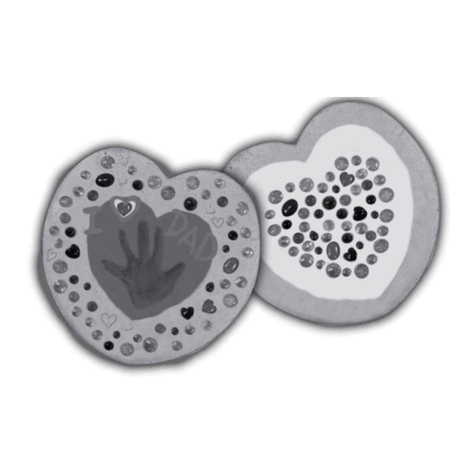
Colorbok
Colorbok You Design It Stepping Stone Easy Step-By-Step Instructions
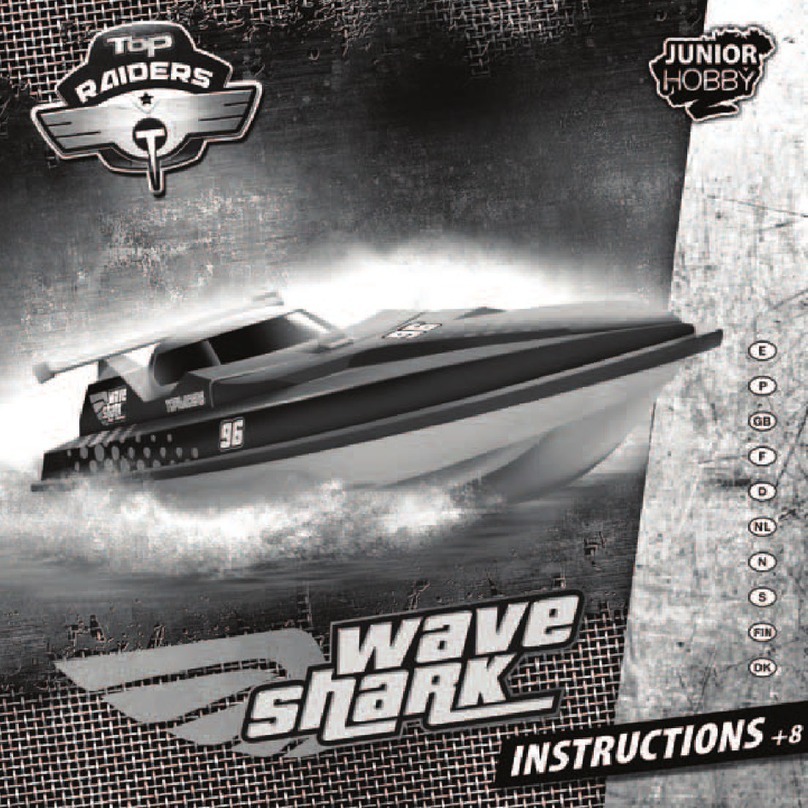
JUNIOR HOBBY
JUNIOR HOBBY Top RAIDERS wave shark Instruction

roco
roco 70075 operating manual
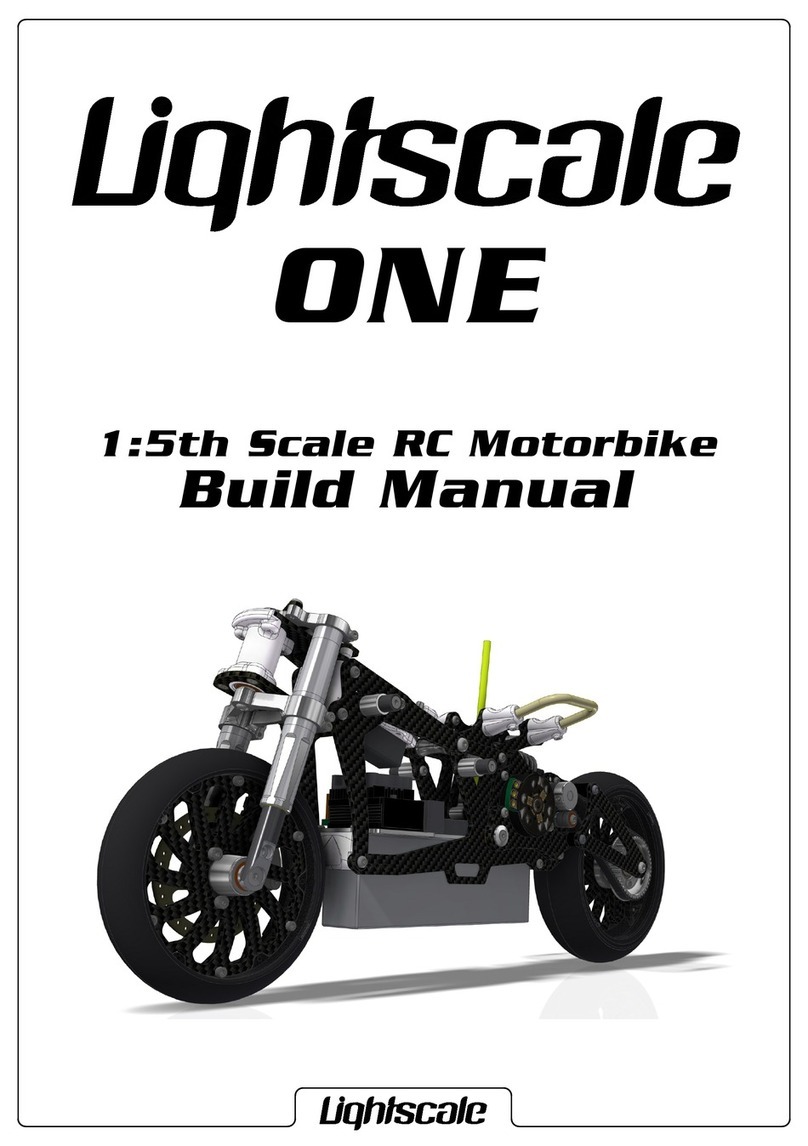
Lightscale
Lightscale One Build manual

Fisher-Price
Fisher-Price V4436 manual

Fisher-Price
Fisher-Price FORD F-150 L6348 Owner's manual & assembly instructions
